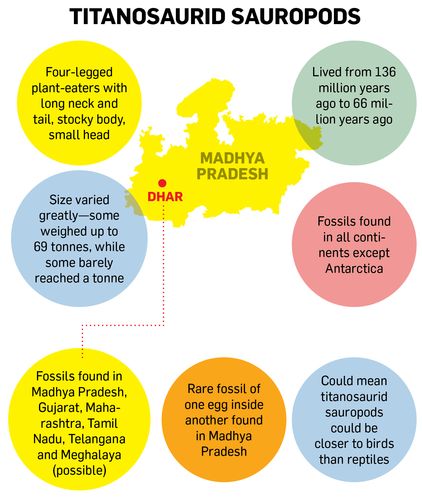The titanosaurid sauropods dominated the Indian subcontinent about 67 million years ago, thumping their pillar-like limbs and waving around their huge tails. It is well known that dinosaurs, birds and crocodiles are close cousins, belonging to the same sub-class of animals (archosaurs), and that birds actually originated from dinosaurs. Still, it is quite difficult to imagine that the towering titanosaurid sauropods were closer biologically to present day birds than reptiles. However, a rare fossil of an ‘abnormal’ dinosaur egg discovered at a village in Dhar district in Madhya Pradesh might help boost this perception and open up a new vista of study on dinosaurs.
The find of the first of its kind ‘ovum-in-ovo’ (one egg inside another) dinosaur egg by a team of Delhi University researchers has thrown open a possibility that as far as the reproductive system went, the titanosaurid sauropods might have been closer to birds, rather than reptiles like crocodiles, lizards and turtles.
The details of the rare discovery were published on June 7 in Scientific Reports, an online publication of the internationally acclaimed journal Nature. The paper said abnormal eggs had been documented earlier in the case of birds, turtles and dinosaurs. However, till this latest find in India, no egg-in-egg cases had been reported in dinosaurs, or for that matter in any other reptiles, anywhere in the world.
The egg-in-egg fossil find has thus given rise to the working hypothesis that the titanosaurid dinosaurs had segmented reproductive tracts like crocodiles and birds, rather than unsegmented tracts like that of lizards and turtles, said Guntupalli V.R. Prasad of the department of geology, Delhi University, and corresponding author of the scientific paper. “Also, the find suggests that these dinosaurs might have actually adopted the sequential egg-laying characteristics of birds—laying one egg at a time, rather than laying all eggs simultaneously like crocodiles, turtles and lizards,” said Harsha Dhiman, lead author of the paper.
The rare egg fossil, measuring about 16.6cm by 14.7cm, was one among 10 eggs found in one of the 52 titanosaurid dinosaur nests close to Padalya village in the Bagh area near Dhar, about 260km from Bhopal. The investigation of the microstructure of the abnormal egg and that of an adjacent egg in the same nest provided evidence that they could be identified with that of titanosaurid sauropod dinosaurs, said Prasad.
Further studies showed that the abnormal egg showed two continuous and circular eggshell layers separated by a wide gap which is typical of birds. Also, the fact that the 10 eggs were spread over a big area lends support to the hypothesis of sequential egg-laying (observed in birds) for the titanosaurid dinosaurs, said Prasad.
The researchers ruled out any other reason for the abnormality noticed in the egg fossil. They discounted the possibility of hatched eggshells accidentally covering adjacent eggs, which was reported from titanosaurid nests of the Auca Mahuevo site in Argentina. In this case, however, the two eggshell layers are not in close contact with each other. “They are separated from each other by a significant gap and maintain a fairly circular outline of the eggs which is not expected if it was caused by accidental and random fall of hatched eggshells,” said the paper.
Explaining the reasons for the abnormality, the researchers said that it was possibly the response of the animals to stress, caused by sickness, competition for space and food resources, scarcity of food, floods and droughts, high population density, environmental stress and the lack of suitable substrates for nesting. “Since the number of pathological eggs documented are very limited (only one) from the present study area, we believe that it was a specific problem and can be attributed to an old or incapacitated individual following injury or sickness or one that underwent significant stress due to jump scare caused by a nearby predator.”
Prasad said the new find highlighted the fact that central and western India held great potential for dinosaur fossils which may offer important information on dinosaur eggs diversity, nesting behaviour and reproductive biology. “The Bagh-Kukshi area holds the key to many such wonderful fossil finds,” said Vishal Verma of Bakaner Higher Secondary School, Dhar, who is another co-author of the paper. “But it needs further systematic scientific exploration.”




